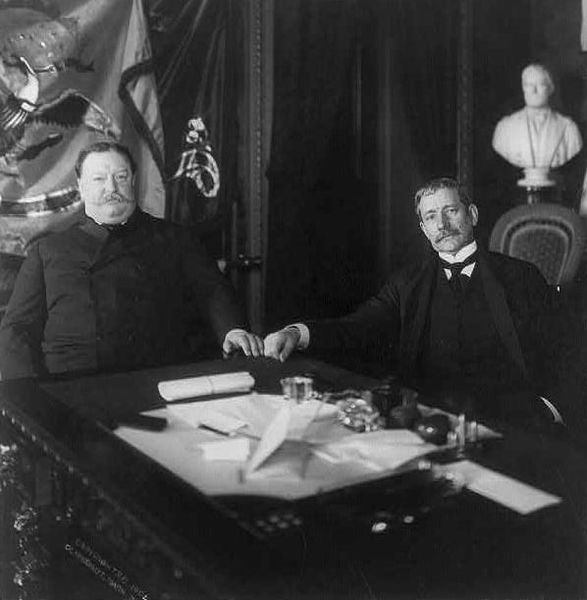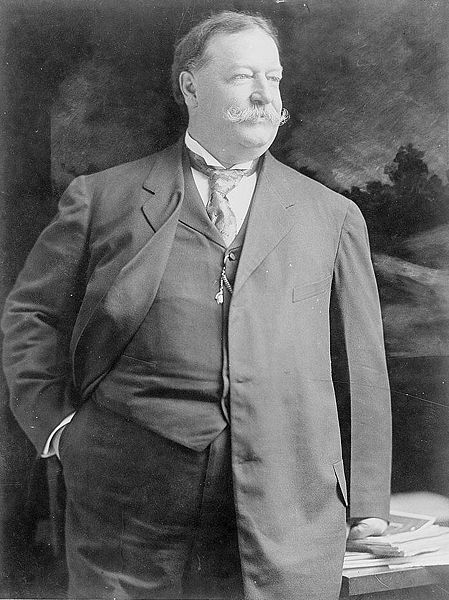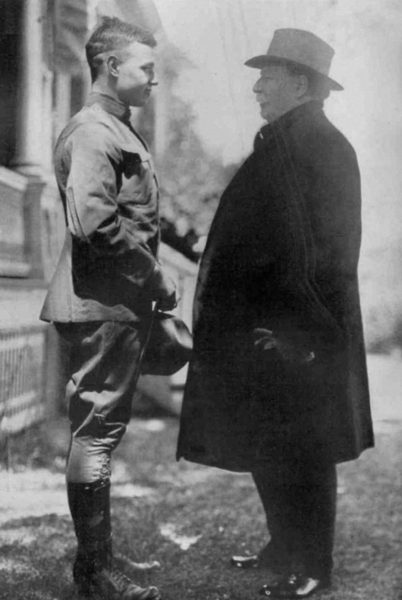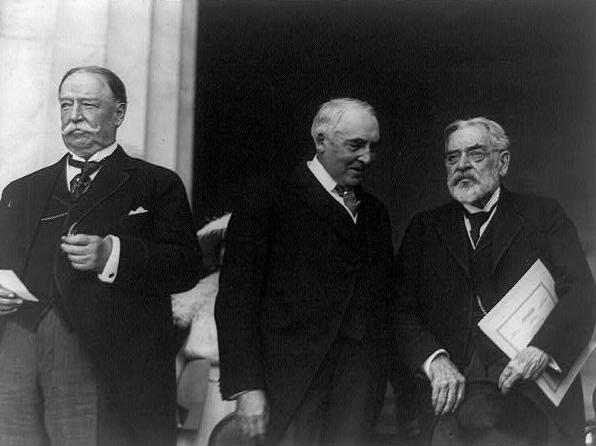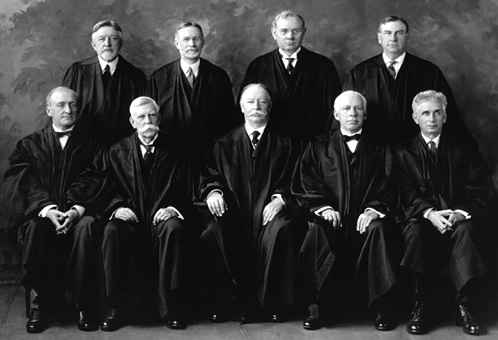<Back to Index>
- Historian Heinrich Gotthard von Treitschke, 1834
- Writer François de La Rochefoucauld, 1613
- 27th President of the United States William Howard Taft, 1857
PAGE SPONSOR
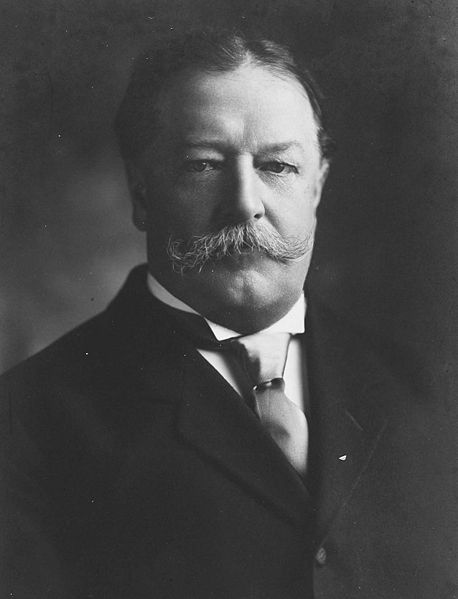
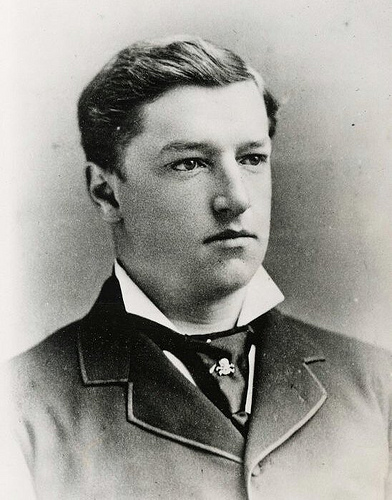
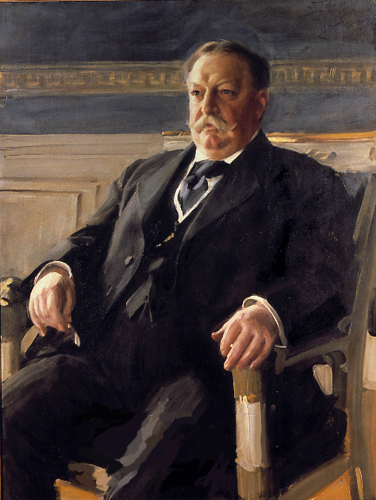
William Howard Taft (September 15, 1857 – March 8, 1930) was the 27th President of the United States and later the tenth Chief Justice of the United States. He is the only person to have served in both offices.
Born in 1857 in Cincinnati, Ohio, into the powerful Taft family, "Big Bill" graduated from Yale College Phi Beta Kappa in 1878, and from Cincinnati Law School in 1880. He worked in a number of local non-descript legal positions until he was tapped to serve on the Ohio Supreme Court in 1887. In 1890, Taft was appointed Solicitor General of the United States and in 1891 a judge on the United States Court of Appeals for the Sixth Circuit. In 1900, President William McKinley appointed Taft Governor - General of the Philippines. In 1904, President Theodore Roosevelt appointed Taft Secretary of War with
the hope that he might groom Taft, his then close political ally, into
his hand picked presidential successor. Riding a wave of popular
support of President (and fellow Republican) Theodore Roosevelt, Taft won an easy victory in his 1908 bid for the presidency. In his first and only term, President Taft's domestic agenda emphasized trust - busting, civil service reform, strengthening the Interstate Commerce Commission, improving the performance of the postal service, and passage of the Sixteenth Amendment. Abroad, Taft sought to further the economic development of underdeveloped nations in Latin America and Asia through "Dollar Diplomacy". However, Taft often alienated his own key constituencies, and was overwhelmingly defeated in his bid for a second term in the presidential election of 1912. After leaving office, Taft spent his time in academia, arbitration, and the search for world peace through his self - founded League to Enforce Peace. In 1921, after the First World War, President Warren G. Harding appointed Taft Chief Justice of the United States.
Taft served in this capacity until shortly before his death in 1930. As
such, he is the only former President to administer the oath of office
to another President, and the only Chief Justice to serve with
associate justices whom he himself had earlier appointed to the court. Weighing
over 300 pounds (140 kg), Taft weighed the most of any American
president. He is the most recent president to have sported facial hair. William Howard Taft was born on September 15, 1857, near Cincinnati, Ohio. His mother, Louisa Torrey, was a graduate of Mount Holyoke College. His father, Alphonso Taft, was the son of Peter Rawson Taft, a descendant of Robert Taft I,
the first Taft in America, who settled in Colonial Massachusetts.
Alphonso Taft went to Cincinnati in 1839 to open a law practice, and was a prominent Republican who served as Secretary of War and Attorney General under President Ulysses S. Grant. The William Howard Taft National Historic Site is
the Taft boyhood home. The house in which he was born has been restored
to its original appearance. It includes four period rooms reflecting
family life during Taft's boyhood, and second - floor exhibits
highlighting Taft's life. In 1900, President William McKinley appointed
Taft chairman of a commission to organize a civilian government in the
Philippines which had been ceded to the United States by Spain
following the Spanish – American War and the 1898 Treaty of Paris. Although
Taft had been opposed to the annexation of the islands, and had told
McKinley his real ambition was to become a justice of the Supreme Court
of the United States, he reluctantly accepted the appointment. From 1901 to 1903, Taft served as the first civilian Governor - General of the Philippines, a position in which he was very popular with both Americans and Filipinos. In 1902, Taft visited Rome to negotiate with Pope Leo XIII for
the purchase of Philippine lands owned by the Roman Catholic Church.
Taft then persuaded Congress to appropriate more than $7 million to
purchase these lands, which he sold to Filipinos on easy terms. In 1903, President Theodore Roosevelt offered
Taft the seat on the Supreme Court to which he had for so long aspired,
but he reluctantly declined since he viewed the Filipinos as not yet
being capable of governing themselves and because of his popularity
among them. In 1904, Roosevelt appointed Taft as Secretary of War. Roosevelt
made the basic policy decisions regarding military affairs, using Taft
as a well - traveled spokesman who campaigned for Roosevelt's reelection
in 1904. Taft
met with the Emperor of Japan who alerted him of the probability of war
with Russia. In 1905, Taft met with Japanese Prime Minister Katsura Tarō. At that meeting, the two signed a secret diplomatic memorandum now called the Taft - Katsura Agreement. Contrary to myth, the memorandum did not establish any new policies but
instead repeated the public positions of both nations. It did not
promise Japan a free hand in Korea. In 1906, President Roosevelt sent troops to restore order in Cuba during the revolt led by General Enrique Loynaz del Castillo, and Taft temporarily became the Civil Governor of Cuba,
personally negotiating with Castillo for a peaceful end to the revolt.
In 1907, Taft helped supervise the beginning of construction on the Panama Canal. Taft
had repeatedly told Roosevelt he wanted to be Chief Justice, not
President (and not an associate justice), but there was no vacancy and
Roosevelt had other plans. He gave Taft more responsibilities along
with the Philippines and the Panama Canal. For a while, Taft was Acting Secretary of State.
When Roosevelt was away, Taft was, in effect, the Acting President.
While Taft was Secretary of War, he authorized the confinement of a
military thief to Fort Leavenworth's United States Disciplinary Barracks; this thief was serial killer Carl Panzram, who burglarized Taft's New Haven, Connecticut home in 1920 and stole a pistol with which he committed several murders.
After serving for nearly two full terms, in a decision that he would come to regret, the popular Theodore Roosevelt refused to run in the election of 1908.
Although Taft seemed like the logical successor, he was initially
reluctant to run. As a member of Roosevelt's cabinet he had once
declared that his future ambition was to serve on the Supreme Court,
not the White House. But, he conceded, were he to get nominated for
president he would put his personal convictions aside and run a
vigorous campaign. At the time Roosevelt was convinced that Taft was a genuine "progressive" and helped push through the nomination of his Secretary of War onto the Republican ticket. Riding the wave of popular support for President Theodore Roosevelt, Taft easily defeated his Democratic opponent William Jennings Bryan by 159 electoral votes in the election of 1908. At age 51, and after a legal and political career of more than 20 years, Taft ran in an election for the first time.
His opponent was William Jennings Bryan, who had run for president twice before, in 1896 and in 1900 against William McKinley. During the campaign, Taft undercut Bryan's liberal support by accepting
some of his reformist ideas, and Roosevelt's progressive policies
blurred the distinctions between the parties. Bryan, on the other hand,
ran a vigorous campaign against the nation's business elite. In the
end, Taft won by a comfortable margin, giving Bryan his worst loss in
three presidential campaigns.
Taft fought for the prosecution of trusts (eventually issuing 80 lawsuits), further strengthened the Interstate Commerce Commission, established a postal savings bank and a parcel post system, and expanded the civil service. He supported the 16th Amendment, which allowed for a federal income tax, and the 17th Amendment, mandating the direct election of senators by the people, replacing the previous system whereby they were selected by state legislatures.
Taft
did not enjoy the easy relationship with the press that Roosevelt had,
choosing not to offer himself for interviews or photo opportunities as
often as the previous president had done. When
a reporter informed him he was no Teddy Roosevelt, Taft replied that
his goal was to "try to accomplish just as much without any noise". Taft
considered himself a progressive because of his deep belief in the law
as the scientific device that should be used by judges to solve
society's problems. Taft proved a less adroit politician than Roosevelt
and seemed to lack the energy and personal magnetism of his mentor, not
to mention the publicity devices, the dedicated supporters, and the
broad base of public support that made Roosevelt so formidable. When
Roosevelt realized that lowering the tariff would risk severe tensions
inside the Republican Party, pitting producers (manufacturers and
farmers) against department stores and consumers, he stopped talking
about the issue. Taft ignored the risks and tackled the tariff boldly,
on the one hand encouraging reformers to fight for lower rates, and
then on the other hand cutting deals with conservative leaders that
kept overall rates high. The resulting Payne - Aldrich Tariff Act of 1909 was too high for most reformers, but instead of blaming this on Senator Nelson W. Aldrich and
big business, Taft took credit, calling it the best bill to come from
the Republican Party. Again, he had managed to alienate all sides. Unlike
Roosevelt, Taft never attacked business or businessmen in his rhetoric.
However, he was attentive to the law, so he launched 90 antitrust suits, including one against the country's largest corporation, U.S. Steel,
for an acquisition that Roosevelt personally had approved. As a result,
Taft lost the support of antitrust reformers (who disliked his
conservative rhetoric), of big business (which disliked his actions),
and of Roosevelt, who felt humiliated by his protégé. Progressives within the Republican Party began to agitate against Taft. Senator Robert LaFollette of Wisconsin created
the National Progressive Republican League to replace Taft at the
national level; his campaign crashed after a disastrous speech. Most of
LaFollette's supporters went over to Roosevelt, leaving LaFollette
embittered and alone. More trouble came when Taft fired Gifford Pinchot, a leading conservationist and close ally of Roosevelt. Pinchot alleged that Taft's Secretary of Interior Richard Achilles Ballinger was
in league with big timber interests. Conservationists sided with
Pinchot, and Taft alienated yet another vocal constituency with the Pinchot - Ballinger controversy. Taft actively pursued what he termed "Dollar Diplomacy"
to further the economic development of less developed nations of Latin
America and Asia through American investment in their infrastructures. Throughout the early part of his presidency, he had difficulties with Nicaragua. When the United States shifted its interests to Panama to build a canal, Nicaraguan President José Santos Zelaya negotiated
with Germany and Japan in an unsuccessful effort to have a canal
constructed in his country. The Zelaya administration had growing
friction with the United States government, which started giving aid to
his Conservative opponents in Nicaragua. In 1907, U.S. warships seized
several of Nicaragua's seaports. In early December, United States Marines landed on Nicaragua's Caribbean Sea coast. On December 17, 1909, Zelaya resigned and left for exile in Mexico. The U.S. sponsored conservative regime of Adolfo Díaz was
installed in his place. Military invasions with marine landings took
place in 1910 and 1912, and the Marines stayed in Nicaragua through
1925. One
of Taft's main goals while President was to further the idea of world
peace. Given his judicial sensibilities, he believed that international
arbitration was the best means to effect the end of war on Earth. As
a result, he championed several reciprocity and arbitration treaties.
In 1910, he persuaded congressional Democrats to support a reciprocity,
or free trade, treaty with Canada, but the Liberal Canadian government of Sir Wilfrid Laurier that negotiated the treaty was turned out of office in 1911 and the treaty collapsed (a US - Canada reciprocity treaty would not come into effect until 1988). In
1910 and 1911, however, Taft secured the ratification of arbitration
treaties that he had successfully negotiated with Britain and France,
and thereafter was known as one of the foremost advocates of world
peace and arbitration. To solve an impasse during the 1909 tariff debate, Taft proposed income taxes for corporations and a constitutional amendment to remove the apportionment requirement for taxes on incomes from property
(taxes on dividends, interest, and rents), on June 16, 1909. His
proposed tax on corporate net income was 1% on net profits over $5,000.
It was designated an excise on the privilege of doing business as a
corporation whose stockholders enjoyed the privilege of limited liability, and not a tax on incomes as such. In 1911, the Supreme Court, in Flint v. Stone Tracy Co., upheld the tax. Receipts grew from $21 million in the fiscal year 1910 to $34.8 million in 1912. In
July 1909, a proposed amendment to remove the apportionment requirement
was passed unanimously in the Senate and by a vote of 318 to 14 in the
House. It was quickly ratified by the states, and on February 3, 1913,
it became a part of the Constitution as the Sixteenth Amendment, just as Taft was leaving office.
Taft was reluctant to use federal authority to enforce the 15th amendment to the U.S. Constitution, which guaranteed African Americans the right to vote. As a result, state governments were able to enforce voter registration requirements that prevented African Americans from voting. Lynching by whites was common throughout the South at the time; however, Taft did nothing to stop the practice. Taft publicly endorsed Booker T. Washington's program for uplifting the black race, advising them to stay out of politics at the time. A
supporter of free immigration, Taft vetoed a law passed by Congress
that would have restricted admissions by imposing a literacy test. On
his return from Europe, Roosevelt broke with Taft in one of the most
dramatic political feuds of the 20th century. To the surprise of
observers who thought Roosevelt had unstoppable momentum, Taft
outmaneuvered both Roosevelt and Senator Robert M. La Follette, Sr.,
then seized control of the GOP, and forced both out of the party. The
main issue in 1911 – 12 was independence of the judiciary, which
Roosevelt denounced. Most lawyers in the GOP supported Taft, including
many of Roosevelt's key supporters like Elihu Root, Henry L. Stimson, and Roosevelt's own son-in-law, Nicholas Longworth.
In lining up delegates for the 1912 nomination, Taft outmaneuvered
Roosevelt, who had started much too late, and kept control of the
Republican Party. In
1912, some delegates were chosen for the first time through primary
elections, which were seen as a way to take power away from party
bosses and put it into the hands of the people. Out of the 14
Republican primaries held, Roosevelt won nine, while Taft won only
three, and LaFollette won the other two. Nevertheless, Taft had the
delegates, and won the nomination at the Republican nominating
convention in Chicago. Because he had not secured the Republican nomination, Roosevelt was forced to create the Progressive Party (or "Bull Moose") ticket, splitting the Republican vote in the 1912 election. Woodrow Wilson,
the Democrat, was elected, although many historians argue that Wilson
would have won anyway, because the Republican factions would not
support each other. Taft won the mere eight electoral votes of Utah and Vermont,
making his the single worst defeat in American history for an incumbent
President seeking reelection; he finished not even second, but third,
behind both Wilson and Roosevelt. In
spite of his failure to be re-elected, however, Taft achieved what he
felt were his main goals as President: keeping permanent control of the
party and keeping the courts sacrosanct until they were next threatened.
It also should be noted that while the strife during the election of
1912 devastated the once very close friendship between Taft and
Theodore Roosevelt, the two eventually did reconcile not long before
Roosevelt's death in 1919. During his presidency, Taft appointed the following Justices to the Supreme Court of the United States: Taft's six appointments to the Court rank below only those of George Washington (who appointed all six justices to the first Court), and of Franklin D. Roosevelt (who was president for just over twelve years). Taft's appointment of five new justices tied the number appointed by both Andrew Jackson and Abraham Lincoln. Four of Taft's appointees were relatively young, aged 48, 51, 53, and 54. The
appointments of Edward Douglass White and Charles Evans Hughes also are
notable because Taft essentially appointed both his predecessor and
successor Chief Justices, respectively. Hughes initially was appointed
an Associate Justice, but later resigned to run for the Republican Party's presidential candidate in the 1916 election, which he would lose. President Herbert Hoover renominated Hughes to the Supreme Court as Chief Justice following Taft's retirement.
Besides his Supreme Court appointments, Taft appointed 13 judges to the United States Courts of Appeals, and 38 judges to the United States district courts. Taft also appointed judges to various specialty courts, including the first five appointees each to the United States Commerce Court and the United States Court of Customs Appeals. The Commerce Court was abolished in 1913; Taft was thus the only President to appoint judges to that body. Upon leaving the White House in 1913, Taft was appointed the Chancellor Kent Professor of Law and Legal History at Yale Law School. At the same time, Taft was elected president of the American Bar Association. He spent much of his time writing newspaper articles and books, most notably his series on American legal philosophy. He was a vigorous opponent of prohibition in the United States, predicting the undesirable situation that the Eighteenth Amendment and prohibition would create. He
also continued to advocate world peace through international
arbitration, urging nations to enter into arbitration treaties with
each other and promoting the idea of a League of Nations even before the First World War began. When World War I did break out in Europe in 1914, however, Taft founded the League to Enforce Peace. He was a co-chairman of the powerful National War Labor Board between 1917 and 1918. Although he continually advocated peace, he strongly favored conscription once
the United States entered the War, pleading publicly that the United
States not fight a "finicky" war. He feared the war would be long, but
was for fighting it out to a finish, given what he viewed as "Germany's
brutality." On June 30, 1921, following the death of Chief Justice Edward Douglass White, President Warren G. Harding nominated
Taft to take his place. For a man who had once remarked that "there is
nothing I would have loved more than being chief justice of the United
States" the nomination to oversee the highest court in the land was
like a dream come true. There was little opposition to the nomination, and the Senate approved him 60-4 in a secret session on the day of his nomination, but the roll call of the vote has never been made public. Taft
received his commission immediately and readily took up the position,
serving until 1930. As such, he became the only President to serve as
Chief Justice, and thus the only former President to swear in
subsequent Presidents, giving the oath of office to both Calvin Coolidge (in 1925) and Herbert Hoover (in 1929). Taft enjoyed his years on the court and was respected by his peers. Justice Felix Frankfurter once remarked to Justice Louis Brandeis that it was "difficult for me to understand why a man who is so good a Chief Justice... could have been so bad as President. Taft remains the only person to have led both the Executive and Judicial branches of the United States government.
He considered his time as Chief Justice to be the highest point of his
career; allegedly, he once remarked "I do not remember that I was ever
President". In
1922, Taft traveled to Great Britain to study the procedural structure
of the English courts and to learn how they dropped such a large number
of cases quickly. During the trip, King George V and Queen Mary received Taft and his wife as state visitors. With what he had learned in England, Taft decided to advocate the introduction and passage of the Judiciary Act of 1925 (often
called the "Judges Bill"), which shifts the Supreme Court's appellate
jurisdiction to be exercisable principally on review upon litigants'
petitioning to be granted an appeal. The Court then has the power to
accept or deny an appeal. Thereby, the Supreme Court is empowered to
give preference to cases of national importance, and it allows the
Court to work more efficiently (writ of certiorari). Besides
giving the Supreme Court more control over its docket, supporting new
legislation, and organizing the Judicial Conference, Taft gave the
Supreme Court and the Chief Justice general supervisory power over the
scattered and disorganized federal courts. The
legislation also brought the courts of the District of Columbia and of
the Territories (and soon, the Commonwealths of the Philippines and Puerto Rico)
into the Federal Court system. This united the courts for the first
time as an independent third branch of government under the
administrative supervision of the Chief Justice. Taft was also the
first Justice to employ two full-time law clerks to assist him. In 1929, Taft successfully argued in favor of the construction of the first separate and roomy United States Supreme Court building (the
one that is still in use now), reasoning that the Supreme Court needed
to distance itself from the Congress as a separate branch of the
Federal Government. Until then, the Court had heard cases in Old Senate Chamber of the Capitol Building. The Justices had no private chambers there, and their conferences were
held in a room in the Capitol's basement. Unfortunately, Chief Justice
Taft did not live to see the completion of the Court's new building in
1935.
Evidence from eyewitnesses, and from Taft himself, strongly suggests that during his presidency he had severe obstructive sleep apnea because
of his obesity. Within a year of leaving the presidency, Taft lost
approximately 80 pounds (36 kg). His somnolence problem resolved
and, less obviously, his systolic blood pressure dropped 40–50 mmHg (from 210 mmHg). Undoubtedly, this weight loss extended his life. Soon after his weight loss, he had a revival of interest in the outdoors; this led him to explore Alaska. Beginning
in 1920, Taft used a cane; this was a gift from Professor of Geology
W.S. Foster, and was made of 250,000 year old wood. Taft retired as Chief Justice on February 3, 1930, because of ill health. Charles Evans Hughes, whom he had appointed to the Court while president, succeeded him. Five weeks following his retirement, Taft died, on March 8, 1930, the same date as Associate Justice Edward Terry Sanford (who died unexpectedly). As it was customary for members of the court to
attend the funeral of deceased members, this posed a "logistical
nightmare", necessitating cross-country travel. Three days following his demise, on March 11, he became the first president to be buried at Arlington National Cemetery. James Earle Fraser sculpted his grave marker out of Stony Creek granite. Taft is one of two presidents buried at Arlington National Cemetery, the other being John F. Kennedy, and he is one of four Chief Justices buried at Arlington, the others being Earl Warren, Warren E. Burger, and William Rehnquist. Since he had also served as President, Taft was the only Chief Justice to have had a state funeral. In
1938, a third generation of the Taft family entered the national
political stage with the election of the former President's oldest son Robert A. Taft I to the United States Senate representing Ohio; he continued in office as a senator until his death in 1953. President Taft's other son, Charles Phelps Taft II, served as the mayor of Cincinnati from 1955 to 1957. Two more generations of the Taft family later entered politics. The President's grandson, Robert Taft, Jr., served a term as a Senator from Ohio from 1971 to 1977, and the President's great-grandson, Robert A. Taft II, served as the Governor of Ohio from 1999 to 2007. William Howard Taft III was the U.S. ambassador to Ireland from 1953 to 1957. William Howard Taft IV, currently in private law practice, was the general counsel in the former United States Department of Health, Education, and Welfare in the 1970s, was the Deputy Secretary of Defense under Caspar Weinberger and Frank Carlucci in the 1980s, and acted as the United States Secretary of Defense during its vacancy from January to March 1989. In addition, he was a high level official in the United States Department of State from 2000 to 2006. President
Taft's enduring legacy includes many things named after him. Some of
these are the courthouse of the Ohio Court of Appeals for the First
District in Cincinnati, Ohio; streets in Cincinnati, Ohio; Arlington, Virginia; and Manila, Philippines; a law school in Santa Ana, California; and high schools in San Antonio, Texas; Woodland Hills, California; Chicago, Illinois; and The Bronx. Taft Ave. in Manila and Taft, Eastern Samar, a town in the Philippines was named after him. After a fire burned much of the town of Moron, California, in the 1920s, it was renamed Taft, California, in his honor. George Burroughs Torrey painted a portrait of him.
Taft attended Woodward High School and, like most of his family, attended Yale College in New Haven, Connecticut. At Yale, he was a member of the Linonian Society, a literary and debating society; Skull and Bones, the secret society co-founded by his father in 1832; and the Beta chapter of the Psi Upsilon fraternity.
He was given the nickname "Big Lub " because of his size, but his college friends knew him by the nickname "Old Bill". Taft
received insults about his weight throughout his life: as
Governor - General of the Philippines, Taft once sent a telegram to
Washington, D.C. that read, "Went on a horse ride today; feeling good;"
Secretary of War Elihu Root replied, "How's the horse?" Despite his weight, Taft was at one point Yale's intramural heavyweight wrestling champion. In 1878, Taft graduated from Yale, ranking second in his class out of 121. After college, he attended Cincinnati Law School, graduating with a Bachelor of Laws in 1880. While in law school, he worked on the area newspaper The Cincinnati Commercial.
After admission to the Ohio bar, Taft was appointed Assistant Prosecutor of Hamilton County, Ohio, based in Cincinnati. In 1882, he was appointed local Collector of Internal Revenue. Taft married his longtime sweetheart, Helen Herron, in Cincinnati in 1886. In 1887, he was appointed a judge of the Ohio Superior Court. In 1890, President Benjamin Harrison appointed him Solicitor General of the United States. As of January 2010, at age 32, he is the youngest ever Solicitor General. Taft then began serving on the newly created United States Court of Appeals for the Sixth Circuit in 1891. Taft was confirmed by the Senate on March 17, 1892, and received his commission that same day. In about 1893, Taft decided in favor of one or more patents for processing aluminium belonging to the Pittsburg Reduction Company, today known as Alcoa, who settled with the other party in 1903 and became for a short while the only aluminum producer in the U.S. Another of Taft's opinions was Addyston Pipe and Steel Company v. United States (1898).
Along with his judgeship, between 1896 and 1900 Taft also served as the
first dean and a professor of constitutional law at the University of Cincinnati.
